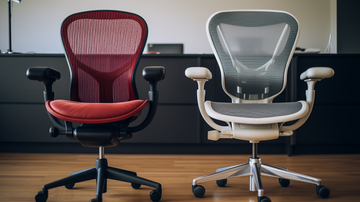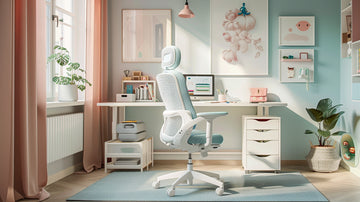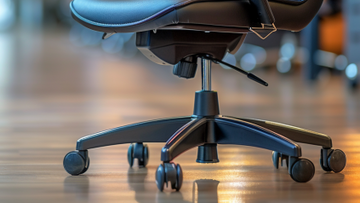Introduction
Mesh and fabric office chairs have become increasingly popular options for both home and office use. Both materials offer distinct advantages in breathability, comfort, design, and cost. This article will provide an overview of mesh and fabric chairs, comparing the materials and helping you decide which type of chair is right for your needs.
Mesh chairs feature open, woven seat backs and seats made of elastic polymer mesh material. This allows air to pass through freely, offering breathable comfort. Fabric chairs have cushioned seats and backs covered in fabric upholstery for a more traditional, plush feel. While mesh promotes airflow, fabric provides softness and warmth.
Over the past decade, mesh chairs have surged in popularity for their ergonomic support, stylish appearance, and affordability compared to leather. Meanwhile, fabric upholstery remains favored for its luxurious look and cushy feel. This article will delve into the pros and cons of each material to help guide your purchasing decision.
History of Mesh and Fabric Chairs
Mesh office chairs first appeared in the 1990s as companies experimented with new materials to improve breathability and comfort in office seating. The open weave structure allowed for more air circulation than traditional padded fabric chairs.
Fabric office chairs have been around since the 1950s and 60s when office work started to become more common. Early models used wool, cotton and vinyl fabrics. By the 1970s, molded foam and cushioned fabrics became popular for computer and desk workstation seats.
Over time, new synthetic mesh materials were developed that provided structure and support while remaining breathable. This allowed mesh chairs to gain popularity in the 1990s and 2000s. Meanwhile, fabric chairs incorporated more padding, ergonomic shapes and stretchable fabrics to enhance comfort.
Today mesh and fabric chairs coexist in the office furniture market, each with their own unique advantages. Mesh is known for breathability while fabric provides classic style. With innovations in both categories, the choice often comes down to personal preference and finding the best option for your needs.
Materials Used
The materials used for mesh and fabric office chairs can vary greatly and impact the chair's overall performance and feel.
Mesh chair seats are typically made from a flexible, breathable polymer material that resembles woven mesh. Common materials include polyester, nylon, and polyethylene vinyl acetate (PEVA). The mesh forms an open weave pattern with spacing between the intersecting strands to allow for airflow.
Meanwhile, fabric chair seats use a wide variety of textiles and fabrics. These include polyester, nylon, wool, microfiber, leather, and blended fabrics. The fabrics can have different weave patterns, stretch, and thickness. Upholstered foam or padding is often used underneath the fabric for cushioning.
The frame and other parts of mesh and fabric chairs are commonly built from metals like steel, aluminum, and alloys which provide structure and support. Plastics are also sometimes used for adjustable arms or back supports.
Breathability
One of the key differences between mesh and fabric office chairs is breathability. Mesh chairs are designed with an open weave pattern made from elastic polymer material. This structure allows air to freely pass through the seat and backrest. The increased airflow prevents heat and moisture buildup, keeping you cooler and more comfortable as you sit.
Fabric chairs, on the other hand, are made from solid materials like leather, cotton, or wool. These fabrics do not allow air to flow through them well. As you sit in a fabric chair, your body heat can become trapped, causing you to feel hot and sweaty over time. The lack of breathability in fabric chairs makes them a poor choice for long sitting sessions.
If staying cool is a priority for you, a mesh office chair is the clear winner. The open weave keeps air circulating so you avoid getting too warm. Fabric chairs simply can't compete when it comes to breathability and comfort.
Comfort
Comfort often tops the list for most people when it comes to choosing between mesh and fabric chairs. Here's an overview of the pros and cons of each material when it comes to comfort:
Mesh Chairs
Pros:
- The breathable mesh material allows for more airflow, keeping you cooler.
- Mesh gently conforms to your body shape and provides good lumbar support.
- The flexibility and give of mesh material can make it more comfortable for long sitting sessions.
Cons:
- Mesh seats with inadequate cushioning or support can feel hard and uncomfortable over time.
- The give of mesh means it lacks the enveloping comfort and plush feel of upholstered chairs.
Fabric Chairs
Pros:
- Cushioned upholstered seats provide plush, enveloping comfort and support.
- Thick padded cushions are enjoyable to sit on for extended periods.
Cons:
- Fabric can retain heat, making chairs less breathable and prone to getting hot.
- Heavily cushioned chairs lack lumbar support and conform less to your body shape.
Design and Aesthetics
The appearance and overall look of mesh and fabric chairs can vary significantly. Mesh chairs often have a more modern, minimalist aesthetic with the mesh material prominently visible across the entire backrest. This gives them a lightweight, almost see-through appearance. Fabric chairs, on the other hand, come in a wider variety of styles. From classic leather executive chairs to plush padded seats, fabric can create a more traditional, opulent look. Upholstered chairs also allow for more colorful, patterned and textured designs compared to the relatively plain look of mesh.
Mesh materials come in a limited color palette, usually black, gray or transparent mesh. Fabric chairs offer many more possibilities when it comes to colors, prints and textures. You can find chairs upholstered in leather, microfiber, polyester, wool, cotton, linen and more. So if you want your chair to complement your office décor and look stylish, a fabric chair provides more design options. But mesh chairs have their own understated aesthetic that works well in modern, minimalist spaces.
Durability
When it comes to durability, both mesh and fabric office chairs have pros and cons. Mesh is very breathable but can tear more easily over time, especially on areas that receive a lot of stress like the seat. High quality mesh is more durable but lower quality mesh can begin to sag and lose its tautness.
Fabric is generally more durable than mesh and less prone to tearing since it has some stretch and give. Tightly woven fabrics like polyester stand up very well to daily use without pilling or fraying. The main durability issue with fabric chairs is potential discoloration from sunlight, spills, or body oils penetrating the fabric over time.
To maximize the lifespan of both chair types, look for high-density, thickly woven mesh or fabric. Reinforced stitching around high stress areas also improves durability. No matter what office chair you choose, avoid excessive moisture and sunlight exposure which can degrade materials faster.
Cost
Mesh chairs typically cost less than fabric chairs. This is because mesh is less expensive as a material compared to most fabric upholsteries used for office chairs. The average price of a mesh office chair is $100-300, whereas fabric office chairs usually start around $200 and go up to $1000 or more depending on the fabric quality and brand.
With mesh chairs, you’re mostly paying for the frame and mechanism rather than the material itself. The mesh is lightweight, thin, and inexpensive to produce. Fabric chairs have more complex upholstery construction and thicker cushioning, which costs more. High-end designer fabric chairs made with real leather, wool, or quilted fabrics have the highest prices.
That said, there are budget fabric chairs available too. Ikea’s Markus chair is around $199 with a basic woven fabric, compared to $129 for Ikea’s Jarvfjallet mesh chair. And luxury specialty brands sell high-end mesh chairs with premium mechanisms and stylish designs for $400+. So there is overlap in pricing ranges.
In general though, mesh chairs provide better value and lower cost for the same features like adjustable arms, seat depth, tilt mechanisms, and lumbar support. Companies can sell mesh chairs at a more affordable price point than fabric upholstered chairs with equivalent options.
Best Uses
When deciding between a mesh or fabric office chair, consider how you plan to use the chair. Mesh chairs excel in breathability, making them ideal for hot offices or prolonged sitting. The open mesh back allows air to freely circulate, keeping you cool and comfortable. Mesh chairs are also lightweight and flexible, providing ergonomic support for dynamic tasks like shifting positions.
Fabric chairs tend to offer a more plush, cushy feel. The soft upholstery provides exceptional comfort for longer periods of stationary sitting. Fabric also dampens noise, making these chairs well-suited for quiet settings. The material insulates heat too, making fabric chairs preferable in colder environments. Thick padding gives extra support, ideal for those with back pain.
Evaluate your workspace and needs. Do you want ventilation and movement or cushy support? Mesh best serves active users in warm places, while fabric excels for stationary comfort in cool settings. Consider too how the chair will complement your office decor. Pick mesh for a sleek, modern look or fabric for a homier, upscale feel. With these factors in mind, you can confidently choose between these two great chair styles.
Conclusion
In summary, mesh and fabric office chairs both have their advantages and drawbacks. Mesh chairs excel in breathability and cooling, while fabric upholstery provides a more plush and cushy feel. Aesthetically, fabric lends a more stylish, refined look while mesh has a more minimalist, ergonomic appearance. Fabric is generally more expensive and requires more care than rugged, stain-resistant mesh. For prolonged sitting and intense focus, mesh chairs promote healthy posture and airflow. If leaning back and relaxing is more of a priority, a cushy padded fabric chair may be preferable. Consider where and how the chair will be used, as well as individual preferences for support, flexibility, and comfort. Test different chairs in person whenever possible. With the right match of material and design to your needs and workspace, either a mesh or fabric office chair can be an excellent choice.






